It’s been a little quiet here recently on the Lyminge blog, mainly because the team have been hard at work organising a conference! As a result, there are lots of things that have been happening at Lyminge Project HQ to catch up with, so there will be a couple of blog posts to cover all the exciting developments.

The view of Canterbury Cathedral from the University of Kent campus, where the Lyminge Project conference was held
On 24th April 1oo delegates and speakers decended on the University of Kent, Canterbury, for the long-planned end-of-project conference entitled ‘Early Medieval Monasticism in the North Sea Zone’. The weather was fine and we were all looking forward to a weekend of excellent discussion on the origins and development of monasticism in Northern Europe, with particular reference to the new information gathered from the Lyminge excavations over the past 8 years. The whole project team were excited to hear other academics’ perspectives on Lyminge and comparisons to settlements across the British Isles and further afield.
We began the conference weekend with an optional trip to Lyminge on the Friday afternoon, led by Gabor Thomas, our project director. Gabor took around 40 delegates to the village, showing them the areas that have been excavated since 2008, as well as around the church and churchyard, introducing the tour group to Canon Jenkins’ 19th century investigations.
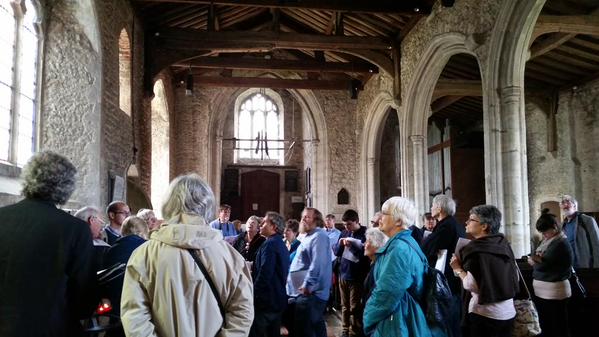
Delegates to the conference were taken on a tour of Lyminge, here learning about the St Mary and St Ethelburga’s Church from Gabor Thomas. Photo by Carolyn Twomey.
Following the field trip was the keynote address by Professor John Blair on ‘Great Hall complexes and minsters in seventh-century England’. John drew together material from his research over the last few years, investigating the planning of Great Hall complexes and their frequent links with nearby Minster sites, putting Lyminge securely into context as both a site that fits this pattern and one that might even have been laid out on a grid system based on ‘short perches’ of about 15 feet.
John’s lecture got us all thinking about the landscapes in which Saxon monasteries and minsters were founded, particularly what kind of historical environment they emerged from. The wine reception that followed was enjoyed very much by all!

Gabor begins the full Saturday of talks with a paper on Lyminge, setting the scene for the conference
We invited speakers who we thought could particularly enlighten the conference topic, and they did not disappoint. In fact, the papers that were given proved to be incredibly cohesive, building a really interesting picture of the state of understanding of Early Medieval monasticism in academia today. Gabor kicked off on the Saturday morning offering a background to the excavations we have undertaken at Lyminge and a context for all the papers that followed that day and the next.
The papers that followed formed the first session, entitled ‘Power and Place’ were given by Professor Ian Wood of the University of Leeds and Professor Barbara Yorke of the University of Winchester, Professor Dries Tys of Brussels University, and Dr John-Henry Clay of Durham University, setting Early Medieval monasticism into its historical context. If you would like detailed titles and abstracts for any of the papers given at the conference, these are still available to download from the Conference 2015 tab on the main website.

(clockwise from left) Prof. Ian Wood, Prof. Barbara Yorke and Prof. Dries Tys speak in the ‘Power and Place’ session.
Some of the most important points to come out of Ian and Barbara’s papers were the difficulties we have in understanding and identifying ‘double monasteries’ or indeed the existence of nunneries in England prior to the 8th century, very important points considering Lyminge has been understood to be an early double monastery headed by an abbess (generally thought of as a monastery with nuns and possibly monks or priests to serve the predominently female institution).

Dr John-Henry Clay speaks to the conference delegates on Saint Boniface’s mission in 8th centry Germany
Dries and John focused on monastic evidence in Northern Europe, with Dries putting Lyminge into context with the archaeological evidence in the Frankish lowlands, and John showing the impact the Angl0-Saxon missions in the 8th century had on central Germany, examining St Boniface’s pastoral strategy and its similarity to practices in Anglo-Saxon England.
The afternoon session on ‘Architecture and Layout’ was a jam packed one! We squeezed in five papers and began with Dame Prof. Rosemary Cramp drawing together our knowledge of monasteries gathered over the last forty years, and establishing where it leaves us today. This overview was a brilliant summation both of the work that Rosemary and many other archaeologists have achieved over the years and of those questions that as yet remain unanswered, with a particular focus on access ways and points of entry as a possible new approach to understanding pre-10th century monasteries.

The spectacular site of Marmoutier, Tours, France, a settlement and monastery that dates from between the 4th – 14th centuries AD. (Photo: http://www.archearegioncentre.org/Marmoutier.html)
Prof. Elisabeth Lorans provided a view of a completely contrasting monastery from France, (for a time contemporary with Lyminge) summarising excavations at Marmoutier, Tours, where the monastic site sits spectacularly on a cliff edge!
While the archaeology couldn’t be more different to our excavations of timber buildings cut into chalk downland, the fact that the topography influenced the development of the site at Marmoutier is an important comparison to the use of the landscape at Lyminge,
with the monastic settlement placed up-slope, perhaps a symbolic separation from the royal vill location, making use of the higher ground for higher impact.
Further case studies followed Elisabeth’s paper, with the Irish perspective from Dr Tomás Ó Carragáin of University College Cork, talking about the fascinating site of Toureen Peakaun, County Tipperary, founded by Beccán in the 7th century. The site has a high quantity of early sculpture and carving, something entirely absent from Lyminge, and the archaeology includes a large earthwork encircling an area of 7th-8th century activity, with the organising of space a key feature at Toureen Peakaun.

The ‘restored’ 12th Century church at Taureen Peakaun (Photo: http://www.megalithicmonumentsofireland.com/ANTIQUITIES_of_IRELAND/ABBEYS/SaintPeakauns_Church.html)
Dr David Petts (Durham University) gave us a brilliant reflection on the state of understanding of Northumbrian monasteries, particularly thinking about the way in which they were laid out – again pointing to the difficulties in understanding layout when excavations are often so ‘key-hole’, but showing that the use of topographic features and landscapes in the division or organisation of space within these sites is a common one.
The afternoon’s session finished with a fantastic paper from Tony Wilmott of Historic England, who has been excavating at Whitby Abbey over a number of years. He explained how much of the very earliest phases of the abbey has potentially been lost to the sea, but that evidence for domestic areas, glass-working and the potential organisation of space with a possible boundary ditch is bringing a much greater understanding of Whitby Abbey and its early monastic origins.
Tony’s enthusiasm for the site at Whitby left the delegates excited about the range and types of early medieval monastic settlements and the potential for a far greater understanding of monasteries of the period with more open area archaeology. His passion for the discoveries at Whitby are summed up in the following image taken by delegate Caroyln Twomey!
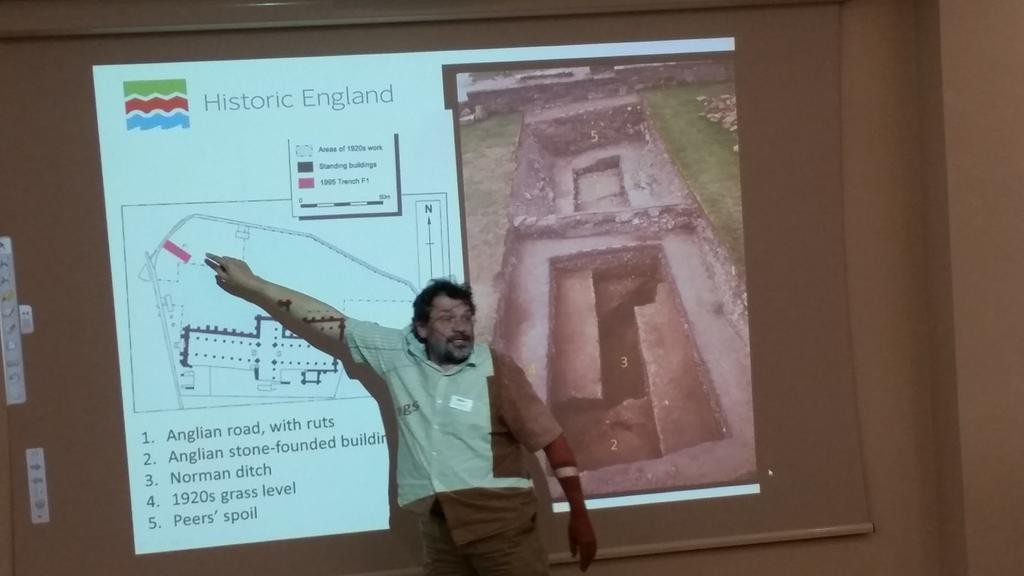
Tony Wilmott of Historic England shows his enthusiasm for the archaeology of Whitby Abbey! (Photo by Carolyn Twomey)
We were especially pleased at the range of attendees at the conference. While we managed to attract some big names in the world of Anglo-Saxon archaeology and history, we were equally pleased to have members of the Lyminge Historical Society and some of our local volunteers on the project, as well as undergraduate and postgraduate students, and archaeologists who work in the commercial sector too.
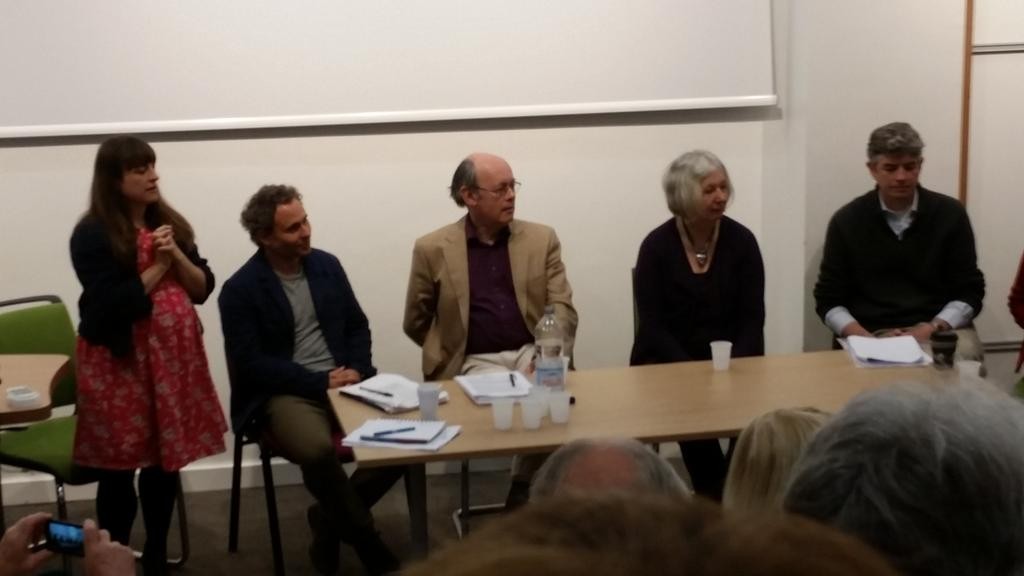
Sunday morning saw the panel discussion address the new research questions on monastic archaeology. L-R Dr Helen Gittos, Dr Gabor Thomas, Prof. John Blair, Prof. Barbara Yorke, Dr Tomás Ó Carragáin.
This range of delegates made for really excellent discussion in the panel session on Sunday morning. Dr Helen Gittos (University of Kent) led the discussions, and slightly panicked the audience by asking us all to move into groups! She asked us to talk about what sort of questions we should be asking regarding Early Medieval monasticism, and how we should seek to answer these questions. Of course, once discussion had got under way everyone had a lot to say, so the initial panic was unjustified!
Drawing the responses together and putting them to the panel made for a really interesting and enjoyable morning, and many delegates commented afterwards that it was wonderful to be able to engage rather than just passively listen to the panel discuss the topics at hand.
It also meant that a highly informed, stimulated and attentive audience awaited the final session of the conference, ‘Monasteries as economic central places’, which focused on resources and production in early medieval monasteries. Dr Justine Bayley examined the evidence for the production of metalwork and glass in monasteries, comparing it to the evidence from other non-monastic settlement sites in order to understand the types of production taking place in these different site types.

(Anti-clockwise from top) Dr Justine Bayley, Dr Mark McKerracher and Zoe Knapp deliver papers on production and consumption in early medieval monasteries
Dr Mark McKerracher was able to focus in on the environmental evidence from the monastic phase at Lyminge, combining the samples he had analysed from Lyminge with his doctoral research, and showing us that the agricultural strategies employed at Lyminge were a combination of both tailoring their crops to the soil type and ‘hedging bets’ with a range of crops. Mark showed that it is possible that monastic settlements and ‘high-status’ sites might share similar archaebotanical ‘signatures’, and emphasised how rich the samples from Lyminge are compared with other sites.

Lyminge’s quite unique pre-Christian zoorchaeological assemblage compared to other sites of a similar date (click to enlarge)
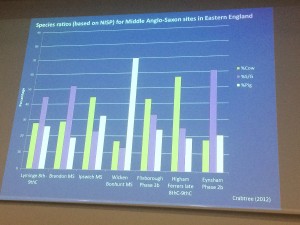
The Monastic phase animal bone assemblage, with proportions of cattle, sheep/goat and pig – completely different to the pre-Christian phase. Click to enlarge.
The conference concluded with the projects’ own PhD student, Zoe Knapp, presenting on her findings to-date from her research on the zooarchaeological assemblage at Lyminge. The sheer size of the assemblage has enabled Zoe to show that there are very significant differences in the animals that were kept and consumed in the monastic phase compared to the pre-Christian settlement. Not only do her results suggest a possible way to identify a monastic settlement with good bone preservation, but it also helps us to begin to think about reasons for change in diet. Zoe suggested that the extremely high quantity of fish and the drop off in consumption of pig may indicate ideological changes in the approach to diet.
The conference ended with intense discussion of the last session, and delegates continued to hang around and discuss the events of the past few days, proving to us how significant an event it was in the re-thinking of Early Medieval monasticism. Indeed, we have had some really fantastic comments from delegates and speakers alike, and are thrilled with the review of one delegate who came all the way from Glasgow and praised the what she considered to be a very non-elitest atmosphere. Her blog review of the conference can be found here.
Although the project team were thoroughly exhausted by the end of the conference, we were all immensely pleased with the way it went, and went away with a whole host of ideas perspectives to consider. We would like to thank the speakers for their fantastic contributions and for helping to make the conference such a success, as well as the brilliantly engaged audience! For those who want lots more information on the papers themselves, keep a look out for the conference proceedings which we are hoping to publish soon – we’ll put up information about publication dates and further information as we get it.
Amazingly enough, there is a further post-script to this intellectual weekend in Kent!

The end of a long day stone-picking on Tayne Field. The first batch of grass seed failed so we’re awaiting the new growth from the second batch very soon! Photo by Paddy Fraser
The discoveries continued the following day – we organised a day of stone-picking in Lyminge: following the backfilling of the 2014 trench a rather large number of loose stones remained on the surface, not ideal for the use of the Tayne Field for sports, picnics and dog-walking. With sterling help from Lyminge project volunteers Jackie Hall, Pete Butcher, Paddy Fraser and Andrew Garrett, as well as a team who were completing Community Service (kindly arranged by Richard Chubb of the Parish Council) we managed to rid Tayne Field of at least twenty bags of stones and flints, finding this gem of a 6th century buckle pin in the process!
Keep a look out for further blog posts in the coming weeks which will explain what happens next with the project. We are by no means ‘done’ even though the last AHRC funded excavation finished eight months ago – but this is all for another post!





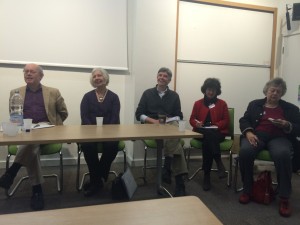


Hi I am Andrew Garretts neice. I am looking for my uncle or paddy, sorry for emailing you guys on here. Many thanks x